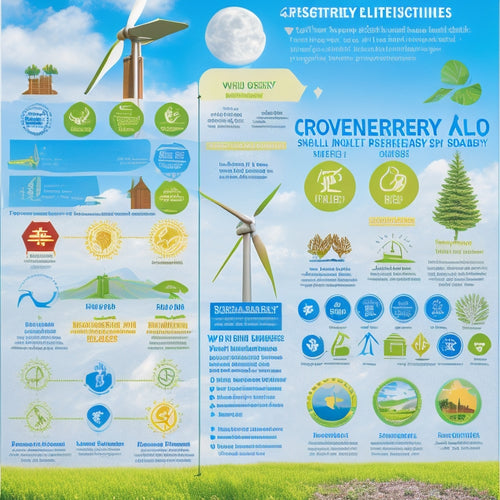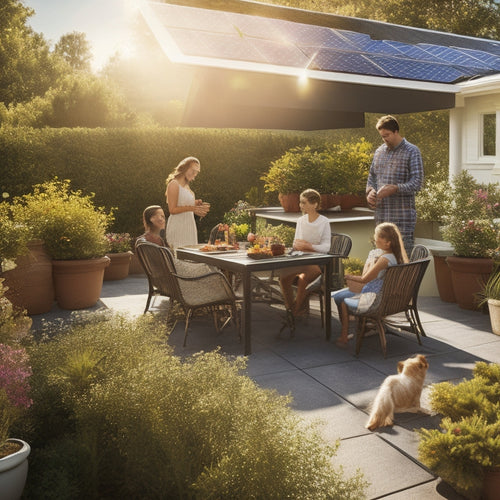Seamlessly Green: Innovative Ways to Integrate Eco-Friendly Solutions at Home
Share
You're taking the first step towards creating a more eco-friendly home. From innovative lighting options like solar lamps and LED retrofitting to energy-efficient kitchen essentials, there are numerous ways to reduce your environmental footprint. You can also transform your space with sustainable decor ideas, such as repurposing vintage items and incorporating plants. Additionally, explore green cleaning product swaps, water conservation hacks, and DIY composting methods to minimize waste. As you set out on this journey, you'll discover even more simple yet impactful changes to make your home seamlessly green.
Key Takeaways
• Implement eco-friendly lighting options like solar lamps, LED retrofitting, and smart bulbs to reduce energy consumption and lower greenhouse gas emissions.
• Upgrade to energy-efficient kitchen appliances with the ENERGY STAR label, and utilize smart plugs for real-time energy usage monitoring.
• Incorporate sustainable decor and furniture, such as repurposed vintage items, eco-friendly fabrics, and sustainable materials, to reduce environmental impact.
• Adopt natural and eco-friendly living practices, including calming color schemes, natural pest control methods, and DIY composting, to promote a healthier environment.
• Make the switch to green cleaning products, opting for natural alternatives, eco-friendly brands, and transparent labeling to minimize environmental harm.
Eco-Friendly Lighting Options
As you seek to reduce your carbon footprint, one of the simplest and most impactful changes you can make is switching to eco-friendly lighting options, which not only benefit the environment but also your wallet.
By choosing sustainable lighting alternatives, you'll substantially lower your energy consumption and reduce greenhouse gas emissions.
Consider incorporating solar lamps into your home, which harness natural sunlight to generate electricity.
This innovative solution is perfect for outdoor spaces, such as patios or walkways.
For indoor spaces, consider LED retrofitting, a process that replaces traditional lighting with energy-efficient LED bulbs.
This cost-effective solution can reduce energy consumption by up to 90%.
Sustainable Home Decor Ideas
By incorporating sustainable home decor ideas into your living space, you'll not only reduce waste and conserve natural resources, but also create a healthier, more eco-friendly environment that reflects your values.
To get started, consider the following sustainable home decor ideas:
| Idea | Why it's Sustainable |
|---|---|
| Repurpose vintage or second-hand items as wall art | Reduces waste and supports sustainable consumption |
| Incorporate plants into your space planning | Purifies the air and improves indoor air quality |
| Choose eco-friendly materials for furniture and decor | Reduces environmental impact and supports sustainable forestry practices |
Green Cleaning Product Swaps
When it comes to cleaning your home, you're likely using products that harm the environment.
You can make a significant impact by swapping out harsh chemical-based cleaners for natural alternatives that are just as effective.
Natural Alternatives Found
You can swap harsh chemical-laden cleaning products for natural alternatives that effectively tackle tough messes and grime without harming the environment or your health.
By making this switch, you'll not only reduce your exposure to toxins but also contribute to a greener, more sustainable lifestyle.
Some natural alternatives you can explore include:
White vinegar: A versatile and non-toxic cleaner that can dissolve dirt and grime, making it perfect for surfaces, mirrors, and windows.
Baking soda: A gentle yet effective abrasive that can help remove stubborn stains and odors, making it ideal for kitchen and bathroom surfaces.
Essential oils: Derived from plants, these oils have antimicrobial properties that can help combat germs and bacteria, making them a great addition to your cleaning routine.
Effective Eco-Friendly Brands
Several eco-friendly brands offer effective green cleaning product swaps that can replace traditional chemical-based cleaners in your home.
You can trust brands that prioritize eco labels, such as the Leaping Bunny Program or EcoLogo, which guarantee that products meet rigorous environmental standards.
When shopping for eco-friendly cleaning products, look for brands that prioritize transparency, like Seventh Generation, which discloses the ingredients used in their products. This brand transparency allows you to make informed decisions about the products you bring into your home.
Another brand, Ecover, is committed to sustainability and uses eco-friendly packaging, reducing waste and minimizing environmental impact.
Energy-Efficient Kitchen Essentials
As you upgrade your kitchen, you'll want to focus on energy-efficient essentials that reduce your environmental footprint.
Swapping out old appliances for eco-friendly alternatives, adopting sustainable cooking methods, and installing energy-saving lighting can make a significant impact.
Eco-Friendly Appliance Options
Upgrading to eco-friendly appliances can substantially reduce your kitchen's carbon footprint, and it starts with swapping out traditional models for energy-efficient alternatives that boast impressive reductions in energy consumption. By choosing appliances with the ENERGY STAR label, you can be confident that you're selecting products that meet rigorous energy efficiency standards.
Opt for Energy-Efficient Refrigerators: Look for models with advanced insulation, high-efficiency compressors, and smart sensors to minimize energy waste.
Smart Plugs for Real-Time Monitoring: Plug your appliances into smart outlets to track energy usage and receive alerts when devices are idle or in standby mode.
Energy Labels for Informed Purchases: When shopping for new appliances, check the EnergyGuide label to compare energy efficiency ratings and make informed decisions.
Sustainable Cooking Methods
You can substantially reduce your kitchen's environmental impact by adopting sustainable cooking methods that not only conserve energy but also promote healthy eating and minimize food waste. One effective way to do this is by incorporating solar ovens into your cooking routine. These innovative appliances use the sun's energy to cook your meals, reducing your reliance on fossil fuels and lowering your carbon footprint.
| Sustainable Cooking Method | Environmental Benefits |
| Solar Oven Cooking | Zero emissions, reduced energy consumption |
| Vegetarian Cuisine | Lower greenhouse gas emissions, reduced water usage |
| Pressure Cooking | Reduced energy consumption, shorter cooking times |
| Slow Cooking | Energy-efficient, reduced food waste |
| Induction Cooking | Energy-efficient, faster cooking times |
Energy-Saving Lighting
Your kitchen's lighting can profoundly impact its overall energy efficiency, and switching to energy-saving lighting options is a crucial step in creating an eco-friendly cooking space. By making a few simple changes, you can substantially reduce your energy consumption and carbon footprint.
Innovative Energy-Saving Lighting Solutions:
Solar Lamps: Harness the power of the sun to light up your kitchen with solar-powered lamps. These eco-friendly lamps are a great option for task lighting and can be easily installed under cabinets or in corners.
Smart Bulbs: Upgrade to smart bulbs that use dramatically less energy than traditional incandescent bulbs. These bulbs can be controlled remotely and scheduled to turn on and off, ensuring you're not wasting energy when not in use.
LED Strip Lighting: Add ambiance and energy efficiency to your kitchen with LED strip lighting. These flexible strips can be placed under countertops, in cabinets, or around appliances to create a warm and inviting atmosphere while using minimal energy.
Water Conservation Hacks
By implementing a few simple water conservation hacks, homeowners can substantially reduce their water waste and lower their utility bills.
One effective way to do this is by installing rain barrels to collect and store rainwater for non-potable uses such as watering plants, washing cars, or flushing toilets. This not only reduces your water consumption but also decreases stormwater runoff and the amount of pollutants that enter local waterways.
Another innovative approach is to utilize grey water, which is the wastewater generated from sinks, showers, and washing machines. By redirecting grey water to irrigate your lawn or garden, you can substantially reduce your potable water usage.
Additionally, consider fixing leaky faucets and installing low-flow fixtures to minimize water waste. By implementing these water conservation hacks, you'll not only reduce your environmental footprint but also save money on your water bill.
Eco-Chic Bedroom Makeover
As you undertake your eco-chic bedroom makeover, you'll want to prioritize sustainable materials, starting with your bed frame.
You'll also need to select eco-friendly fabrics that not only feel luxurious but also minimize environmental harm.
Sustainable Bed Frames
Transforming your bedroom into an eco-friendly oasis begins with the centerpiece of the room: a sustainable bed frame crafted from responsibly sourced materials that not only reduce waste but also add a touch of eco-chic sophistication.
When shopping for a sustainable bed frame, consider the following eco-friendly options:
-
Reclaimed wood: Give old wood a new life by choosing a bed frame made from reclaimed wood. This reduces waste and preserves the history of the original material.
-
Handcrafted designs: Support local artisans who craft unique, handcrafted bed frames using sustainable materials and techniques that minimize waste.
-
Low-VOC finishes: Opt for bed frames with low-VOC (volatile organic compound) finishes, ensuring a healthier indoor environment and reduced air pollution.
Eco-Friendly Fabrics Matter
You can dramatically reduce your carbon footprint by choosing eco-friendly fabrics for your bedding, curtains, and upholstery, which not only benefit the environment but also add a touch of eco-chic sophistication to your bedroom oasis.
When it comes to fabric sourcing, opt for sustainable materials like organic cotton, hemp, or recycled polyester. These eco-friendly fabrics require fewer pesticides, conserve water, and reduce greenhouse gas emissions.
Additionally, consider upcycling or repurposing old fabrics to reduce textile waste. You can also explore textile recycling programs that collect and process old fabrics, turning them into new, usable materials.
Calming Color Schemes
Now that you've selected eco-friendly fabrics, it's time to create a soothing atmosphere with a calming color scheme that promotes relaxation and rejuvenation in your bedroom sanctuary.
A well-curated color palette can profoundly impact your sleep quality and overall well-being.
To get started, create a mood board that reflects your personal style and nature-inspired preferences. This visual representation will help you distill your design vision and identify the perfect hues for your eco-chic bedroom.
Consider the following calming color schemes inspired by nature:
-
Soft Sage: A muted green with undertones of gray, reminiscent of a misty forest morning.
-
Driftwood Grey: A weathered wood-inspired shade that evokes feelings of serenity and calmness.
-
Lavender Dream: A soft, soothing purple hue that promotes relaxation and tranquility.
Natural Pest Control Methods
By adopting natural pest control methods, homeowners can effectively keep unwanted critters at bay while minimizing harm to the environment and their own health.
You can start by exploring companion planting, a technique that involves strategically placing certain plants alongside each other to deter pests.
For instance, basil repels aphids and mites, while marigolds keep nematodes at bay.
This approach not only reduces the need for chemical pesticides but also adds aesthetic value to your garden or indoor space.
When companion planting isn't enough, you can turn to organic pesticides as a safer alternative to synthetic chemicals.
Derived from natural sources like plants, minerals, or bacteria, these pesticides are biodegradable and non-toxic to humans and pets.
Look for products containing neem oil, pyrethrin, or diatomaceous earth, which are effective against a range of pests.
DIY Composting for Beginners
As you adopt natural pest control methods, turning food scraps and yard waste into nutrient-rich soil can further reduce your environmental footprint through DIY composting. This eco-friendly practice not only reduces waste sent to landfills but also creates a nutrient-dense fertilizer for your garden.
To get started, you must understand the different Compost Types. You can choose from hot composting, cold composting, or vermicomposting (worm composting). Vermicomposting, in particular, is an excellent option for small spaces, as it utilizes Worm Habitats to break down organic matter.
Some key takeaways to keep in mind:
-
Start small: Begin with a manageable amount of waste and gradually increase as you gain experience.
-
Balance the mix: Aim for a mix of 2/3 'brown' materials (dried leaves, twigs) and 1/3 'green' materials (food scraps, grass clippings).
-
Monitor moisture: Keep the compost pile moist, like a damp sponge, to facilitate decomposition.
Smart Recycling Strategies
Your recycling habits can substantially impact the environment, and adopting smart recycling strategies can make all the difference.
By implementing effective recycling practices, you can notably reduce waste and contribute to a healthier planet.
One way to do this is by incorporating recycling incentives into your daily routine. For instance, you can set up a recycling reward system, where you earn points or rewards for recycling a certain amount of materials.
Smart Recycling Strategies
| Smart Recycling Strategies | Benefits |
| Implement recycling incentives | Encourages recycling habits |
| Conduct waste analytics | Identifies areas for improvement |
| Create a recycling schedule | Streamlines recycling process
Zero-Waste Lifestyle Tips
Embracing a zero-waste lifestyle requires a mindset shift, where you prioritize reducing waste in every aspect of your daily life. It's about adopting mindful consumption habits, being intentional with your purchases, and making conscious choices to minimize your environmental footprint.
Track your waste: Keep an eco diary to monitor your daily waste output, identifying areas for improvement and tracking your progress.
Adopt minimalist habits: Reduce clutter, reuse items when possible, and avoid single-use products to minimize waste generation.
Embrace sustainable fashion: Invest in high-quality, eco-friendly clothing, and consider swapping or renting items for special occasions to reduce fashion waste.
Frequently Asked Questions
How Do I Convince My Family to Adopt Eco-Friendly Habits?
You'll successfully convince your family to adopt eco-friendly habits by involving them in the process, making it a fun, collaborative effort, and creating routines that become second nature through consistent practice and positive reinforcement.
Are Eco-Friendly Products Always More Expensive Than Traditional Ones?
You'll find that eco-friendly products aren't always pricier; in fact, some cost the same or even less than traditional alternatives. Conduct a cost comparison to uncover the most budget-friendly options, considering price dynamics that may favor eco-friendly choices.
Can I Still Achieve an Eco-Friendly Home on a Tight Budget?
You can still achieve an eco-friendly home on a tight budget by making budget swaps, incorporating thrifty decor, repurposing items, and taking on DIY projects that promote frugal living.
How Do I Measure the Environmental Impact of My Lifestyle Changes?
You measure the environmental impact of your lifestyle changes by tracking your carbon footprint using tools like carbon calculators, and evaluating sustainable metrics like energy consumption, water usage, and waste reduction.
Are There Any Eco-Friendly Alternatives to Single-Use Plastics?
You're looking for eco-friendly alternatives to single-use plastics! Explore bioplastic options made from renewable resources like corn starch or sugarcane. Make zero waste swaps by switching to reusable bags, beeswax wraps, and stainless steel straws.
Related Posts
-

Renewable Energy Certifications for Businesses
Renewable energy certifications are essential for your business, showcasing your commitment to sustainability and enh...
-

Long-Term Cost Savings With Solar Panels
Investing in solar panels offers substantial long-term savings on energy costs. You'll benefit from federal tax credi...
-

Comparative Analysis of Top Solar Brands
To conduct a comparative analysis of top solar brands, focus on key metrics like durability, energy efficiency, and s...


